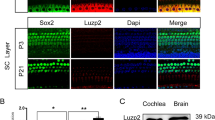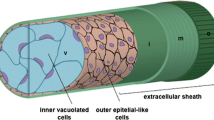Abstract
The gene Fgf-3 is expressed in rhombomeres 5 and 6 of the hindbrain and has been functionally implicated in otic development. We describe new sites of expression of this gene in mouse embryos in the forebrain, the midbrain-hindbrain junction region, rhombomere boundaries, a cranial surface ectodermal domain that includes the otic placode, and in the most recently formed somite. In the early hindbrain, high levels of Fgf-3 transcripts are present in rhombomere 4. The surface ectodermal domain at first (day 81/2) extends laterally from rhombomeres 4 and 5 (prorhombomere B), in which neuroepithelial levels of expression are highest, to the second pharyngeal arch ventrally; at day 9, when the region of highest level of neuroepithelial Fgf-3 expression is in rhombomeres 5 and 6, the dorsal origin of the surface ectodermal domain is also at this level, extending obliquely to the otic placode and the second arch. The initially high level of Fgf-3 transcripts in the otic placode is downregulated as the placode invaginates to form the otic pit. Fgf-3 is a good marker for the epithelium of pharyngeal arches 2 and 3, and our in situ hybridization results confirm the dual identity of the apparently fused first and second arches in some retinoic acid-exposed embryos, and the fusion of the first arch with the maxillary region in others. Correlation between Fgf-3 expression and morphological pattern in craniofacial tissues of normal and retinoic acid-exposed embryos indicates that prorhombomere B, the second arch and the otic ectoderm represent a cranial segment whose structural integrity is maintained when hindbrain morphology and pharyngeal arch morphology are altered. Comparison of normal Fgf-3 expression domains with those of Fgf-4 and with the phenotype of Fgf-3-deficient mutant embryos suggests that there is some functional redundancy between Fgf-3 and Fgf-4 in otic induction and second arch development.
Similar content being viewed by others
References
Baird A, Klagsbrun M (1991) Nomenclature meeting: report and recommendations. The fibroblast growth factor family. Ann NY Acad Sci 638: xiii-xvi
Becker N, Seitanidou T, Murphy P, Mattéi M-G, Topilko P, Nieto MA, Wilkinson D, Charnay P, Gilardi-Hebenstreit P (1994) Several receptor tyrosine kinase genes of the Eph family are segmentally expressed in the developing hindbrain. Mech Dev 47: 3–17
Couly G, LeDouarin NM (1990) Head morphogenesis in avian chimeras: evidence for a segmental pattern in the ectoderm corresponding to the neuromeres. Development 108: 543–558
Crossley P, Martin GR (1995) The mouse Fgf-8 gene encodes a family of polypetides and is expressed in regions that direct outgrowth and patterning in the developing embryo. Development 121: 439–451
Deol MS (1964) The abnormalities of the inner ear in kreisler mice. J Embryol Exp Morphol 12: 475–490
Dickson C, Peters G (1987) Potential oncogene product related to growth factors. Nature 326: 833–837
Dickson C, Smith R, Brookes S, Peters G (1984) Tumorigenesis by MMTV: proviral activation of a cellular gene in the common integration region int-2. Cell 37: 529–536
Frohman MA, Martin GR, Cordes SP, Halamek L, Barsh GS (1993) Altered rhombomere specific expression and hyoid bone differentiation in the mouse segmentation mutant kreisler (kr). Development 117: 925–936
Grinberg D, Thurlow J, Watson R, Smith R, Peters G, Dickson C (1991) Transcriptional regulation of the int-2 gene in embryonal carcinoma cells. Cell Growth Differ 2: 137–143
Harrison RG (1935) Factors concerned in the development of the ear in Amblystoma punctatum. Anat Rec 64 [Suppl 1]: 38–39
Hunt P, Wilkinson D, Krumlauf R (1991) Patterning the vertebrate head: murine Hox 2 genes mark distinct subpopulations of premigratory and migrating neural crest. Development 112: 43–50
Kaufman MH (1992) The atlas of mouse development. Academic Press, London
Lammer EJ, Armstrong DL (1992) Malformations of hindbrain structures among humans exposed to isotretinoin (13-cis-retinoic acid) during early embryogenesis. In: Morriss-Kay GM (ed) Retinoids in normal development and teratogenesis. Oxford University Press, Oxford, pp 281–295
Mahmood R, Kiefer P, Guthrie S, Dickson C, Mason I (1995a) Multiple roles for FGF-3 during cranial neural development in the chicken. Development 121: 1399–1410
Mahmood R, Bresnick J, Hornbruch A, Mahony C, Morton N, Colquhoun K, Martin P, Lumsden A, Dickson C, Mason I (1995b) FGF8 in the mouse embryo: a role in the initiation and maintenance of limb bud outgrowth. Curr Biol 5: 797–806
Mansour SL, Martin GR (1988) Four classes of mRNA are expressed from the mouse int-2 gene, a member of the FGF gene family. EMBO J 7: 2035–2041
Mansour SL, Goddard JM, Capecchi MR (1993) Mice homozygous for a targeted disruption of the proto-oncogene int-2 have developmental defects in the tail and inner ear. Development 117: 13–28
Mason I, Fuller-Pace F, Smith R, Dickson C (1994) FGF 7 expression during mouse development suggests roles in myogenesis, forebrain regionalization and epithelialmesenchymal interactions. Mech Dev 45: 15–30
McKay IJ, Muchamore I, Krumlauf R, Maden M, Lumsden A, Lewis J (1994) The kreisler mouse: a hindbrain segmentation mutant that lacks two rhombomeres. Development 120: 2199–2211
Moore R, Casey G, Brookes S, Dixon M, Peters G, Dickson C (1986) Sequence, topography and protein coding potential of mouse int-2. EMBO J 5: 919–924
Morriss GM (1972) Morphogenesis of the malformations induced in rat embryos by maternal hypervitaminosis. J Anat 113: 241–250
Morriss GM, Thorogood PV (1978) An approach to cranial neural crest cell migration in mamalian embryos. In: Johnson MH (ed) Development in mammals, vol 3. Elsevier/North Holland, Amsterdam, pp 363–412
Morriss-Kay GM, Murphy P, Davidson DR, Hill RE (1991) Effects of RA excess on expression of Hox 2.9 and Krox 20 and on morphological segmentation in the hindbrain of mouse embryos. EMBO J 10: 2985–2995
Murakami A, Grinberg D, Thurlow J, Dickson C (1993) Identification of positive and negative regulatory elements involved in the retinoic acid/cAMP induction of Fgf-3 transcription in F9 cells. Nucleic Acids Res 21: 5351–5359
Nieto MA, Gilardi-Hebenstreit P, Charnay P, Wilkinson D (1992) A receptor protein tyrosine kinase implicated in the segmental patterning of the hindbrain and mesoderm. Development 116: 1137–1150
Niswander L, Martin GR (1992) Fgf-4 expression during gastrulation, myogenesis, limb and tooth development. Development 114: 755–768
O'Rahilly R (1963) The early development of the otic vesicle in staged human embryos. J Embryol Exp Morphol 11: 741–755
Represa J, León Y, Miner C, Giraldez F (1991) The int-2 proto-oncogene is responsible for induction of the inner ear. Nature 353: 561–563
Ruberte E, Dollé P, Chambon P, Morriss-Kay G (1991) Retinoic acid receptors and cellular retinoid binding protein. II. Their differential pattern of transcription during early morphogenesis in mouse embryos. Development 111: 45–60
Smith R, Petrers G, Dickson C (1988) Multiple RNAs expressed from the int-2 gene mouse embryonal carcinoma cell lines encode a protein with homology to FGFs. EMBO J 7: 1013–1022
Tannahill D, Issacs HV, Close MJ, Peters G, Slack JMW (1992) Developmental expression of Xenopus int-2 (FGF-3) gene: activation of mesodermal and neural activation. Development 115: 695–702
Van deWater TR, Ruben RJ (1976) Organogenesis of the ear. In: Hinchliffe R, Harrison D (eds) Scientific foundations of otolaryngology. Heineman, London, pp 173–184
Wilkinson DG (1992) In: Wilkinson DG (ed) In situ hybridization; a practical approach. IRL Press, Oxford
Wilkinson DG, Bailes JA, Champion J, McMahon AP (1987a) A molecular analysis of mouse development from 8 to 10 days p.c. detects changes only in embryonic globin expression. Development 99: 493–500
Wilkinson DG, Bailes JA, McMahon AP (1987b) Expression of the proto-oncogene int-1 is restricted to specific neural cells in developing mouse embryos. Cell 50: 79–88
Wilkinson DG, Peters G, Dickson C, McMahon AP (1988) Expression of the FGF-related proto-oncogene int-2 during gastrulation and neurulation in the mouse. EMBO J 7: 691–695
Wilkinson DG, Bhatt S, McMahon AP (1989) Expression pattern of the FGF-related proto-oncogene int-2 suggests multiple roles in fetal development. Development 105: 131–136
Wood H, Pall G, Morriss-Kay GM (1994) Exposure to RA before or after the onset of somitogenesis reveals separate effects on rhombomeric segmentation and 3 hox B gene expression domains. Development 120: 2279–2285
Author information
Authors and Affiliations
Rights and permissions
About this article
Cite this article
Mahmood, R., Mason, I.J. & Morriss-Kay, G.M. Expression of Fǵf-3 in relation to hindbrain segmentation, otic pit position and pharyngeal arch morphology in normal and retinoic acid-exposed mouse embryos. Anat Embryol 194, 13–22 (1996). https://doi.org/10.1007/BF00196311
Accepted:
Issue Date:
DOI: https://doi.org/10.1007/BF00196311




